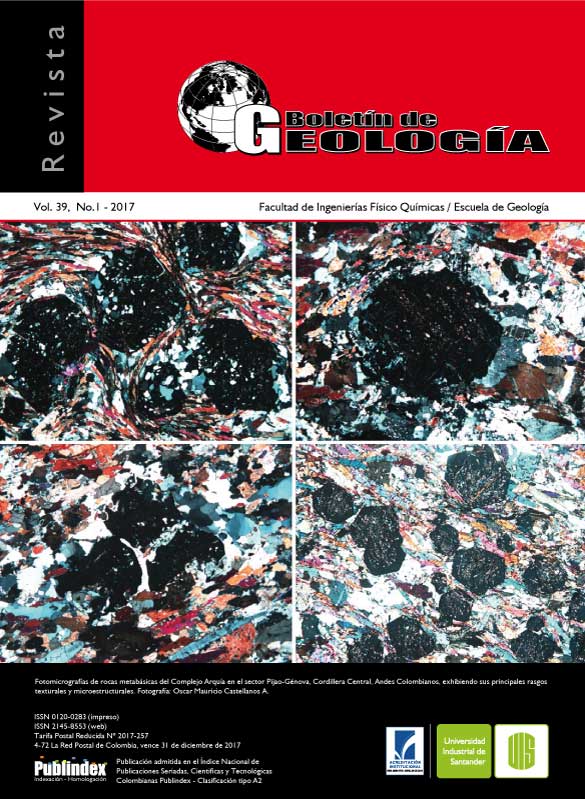YARUMALITO PORPHYRITIC SYSTEM, ANTIOQUIA: PETROGRAPHY AND CHARACTERIZATION OF HYDROTHERMAL ALTERATIONS
Published 2017-03-01
Keywords
- Petrography,
- hydrothermal alterations,
- porphyries,
- phyllosilicates,
- Porphyritic system Yarumalito
How to Cite
Altmetrics
Abstract
This paper describes petrographically sections of drill core (YAR-06, YAR-017 and YAR-019) belonging to the Yarumalite Porphyritic System, in order to identify the lithology and hydrothermal alterations associated with gold mineralization in this system, owned of Colombian Mines Corporation, this project is located 4,3 Km south of the municipality of Valparaiso, Antioquia. The description of these sections bodies is made by the macroscopic analysis of drilling cores, optical petrography and electron microscopy (SEM); petrographically the hypoabisal bodies correspond to andesites and dacites with potassic, propylitic, quartz-sericite and serictic alterations; these alterations have distribution in halos of veins or to the interior of these and less occurs with a distribution pervasive in the rock. In the analyzed sections, the initial pulse corresponds to andesitic porphyries, with potassic, quartzsericitic and propylitic alterations, this pulse is followed by dacitic porphyries that presents the same alterations but with a greater intensity and finally these hypoabisal bodies are cut by small dacitic dykes whose main alteration is sericitic. The mineralogy of the porphyries provides data on the evolutionary stages of the system, for example it is observed as the initial pulse is more basic and progressively goes to compositions moderately more felsic; similarly to the textures of these bodies, which suggest relatively different levels of depth for the identified pulses; on the other hand the secondary textures and hydrothermal alterations presents, suggest a prominent interaction with fluids of magmatic-hydrothermal origin.
Downloads
References
- Alvarán, M. 2006. Consideraciones metalogenéticas del depósito aurífero La Coqueta, distrito minero de Manizales, Villamaría. Tesis de Maestría, Universidad Nacional de Colombia, Bogotá, Colombia. 100p.
- Calle, B., y González, H. 1982. Geología y geoquímica de la plancha 186 Riosucio. Informe No. I-1878. INGEOMINAS. Medellín, 120p.
- Chamois, P. 2011. Technical report on the Caramanta project, departments of Antioquia and Caldas, Colombia. Scott Wilson Rosceo Postle Associates Inc. Toronto, 72 p.
- Colombian Mines Corporation. 2010a. MMI Gold Response Ratio Map. Escala 1:200. Consultado 17 de julio de 2016. http://www.colombianmines.com/ Yarumalito.asp
- Colombian Mines Corporation. 2010b. Yarumalito Simplified Geology Map. Escala 1:200. Colombian Mines Corporation.
- González, H., Cossio, U., Maya, M., Vásquez, E., y Holguín, M. 1999. Geología del departamento de Antiquia, Escala 1:400.000, INGEOMINAS.
- González, H. 2001. Memoria explicativa mapa geológico departamento de Antioquia, escala 1:400.000, INGEOMINAS.
- Guzmán-López, C.A. 2007. Estudio diagenético preliminar de la Formación Amagá. Boletín de Geología, 29(1): 13-20.
- Henrichs, I., Frantz. J.C., Marques, J.C., OrdoñezCarmona, O., Castoldi, M., and Sato, K. 2014. Caracterização e geocronologia SHRIMP U-Pb em zircão dar rochas subvulcânicas do sistema pórfiro Yarumalito, Distrito de Marmato, Colômbia. Pesquisas em Geociências, 41(3): 231-242.
- López, A., Sierra, G., y Ramírez, D. 2006. Vulcanismo Neógeno en el suroccidente antioqueño y sus implicaciones tectónicas. Boletín Ciencias de la Tierra, 19: 27-42.
- Molina, C. 1990. Principales características geológicas y mineralógicas de la mina el cerro Frontino, Antioquia. Boletín Ciencias de la Tierra, 9: 95-112.
- Paris, G., Machette, M., Dart, R.L., and Haller, K.M. 2000. Database and Map of Quaternary faults and folds of Colombia and its offshore regions. Consultado en 24 de mayo 2016. https://pubs.usgs.gov/of/2000/ofr-000284/ofr-00-0284.pdf.
- Ramírez, D., López, A., Sierra, G., y Toro, G. 2006. Edad y proveniencia de las rocas volcánico sedimentarias de la Formación Combia en el suroccidente antioqueñoColombia. Boletín de Ciencias de la Tierra, 19: 9-26.
- Restrepo, J., Toussaint, J., y González, H. 1981. Edades mio-pliocenas del magmatismo asociado a la Formación Combia, departamentos de Antioquia y Caldas, Colombia. Geología Norandina, 3: 21-26.
- Santacruz, L. 2011. Microtermometria de inclusiones fluidas aplicadas al depósito de Marmato. Tesis de pregrado. Universidad Nacional de Colombia, Bogotá, Colombia. 39p.
- Sillitoe, R. 2008. Major gold deposits and belts of the North and South American Cordillera: Distribution, tectonomagmatic setting, and metallogenic considerations. Economic Geology, 103: 663-687.
- Sillitoe, R. 2010. Porphyry copper systems. Economic Geology, 105: 3-41.
- Streckeisen, A. L. 1978. IUGS Subcommission on the Systematics of Igneous Rocks. Classification and Nomenclature of Volcanic Rocks, Lamprophyres, Carbonatites and Melilite Rocks. Recommendations and Suggestions. Neues Jahrbuch für Mineralogie, Abhandlungen, 141: 1-14.
- Thompson, R. 2006. Yarumalito Project Technical Report. Thompson consulting. Utah, 105 p.
- Van der Hammen, T. 1958. Estratigrafía del Terciario y Maestrichtiano continentales y Tectogénesis de los Andes colombianos (con 7 planchas). Boletín Geológico, 6: 67-128.
- Vargas, R. 2005. Evaluación geológica, geoquímica y génesis de la zona de exclusión en Maramato, Caldas, Colombia. Tesis de Maestría. Universidad Nacional de Colombia, Bogotá, Colombia.
- Whitney, D., and Evans, B. 2010. Abbreviations for names of rock-forming minerals. American Mineralogist, 95: 185-187.
